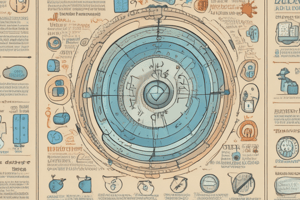Podcast
Questions and Answers
What is the primary reason for pregnancy complications in women with diabetes?
What is the primary reason for pregnancy complications in women with diabetes?
- Increased appetite affects insulin sensitivity.
- The body produces excess insulin during pregnancy.
- Hormonal changes affect insulin sensitivity and glucose control. (correct)
- Insufficient glucose intake leads to complications.
What defines Type 1 Diabetes?
What defines Type 1 Diabetes?
- The body becomes resistant to insulin.
- The immune system attacks insulin-producing cells in the pancreas. (correct)
- Insulin is produced but not effectively used.
- It can be prevented with lifestyle changes.
Which of the following symptoms is more commonly associated with Type 1 Diabetes?
Which of the following symptoms is more commonly associated with Type 1 Diabetes?
- Frequent urination
- Numbness or tingling in hands or feet
- Slow-healing wounds
- Unexplained weight loss (correct)
What does an A1C test measure?
What does an A1C test measure?
What is the normal range for fasting blood glucose levels?
What is the normal range for fasting blood glucose levels?
What is the target range for ketone levels in individuals with type 1 diabetes?
What is the target range for ketone levels in individuals with type 1 diabetes?
At what blood glucose level should a type 1 diabetes patient test their ketones using a Freestyle meter?
At what blood glucose level should a type 1 diabetes patient test their ketones using a Freestyle meter?
Which type of diabetes is most commonly linked to lifestyle factors?
Which type of diabetes is most commonly linked to lifestyle factors?
What is the recommended injection site for insulin in pregnant women?
What is the recommended injection site for insulin in pregnant women?
Which of the following is NOT a cause of diabetic ketoacidosis (DKA)?
Which of the following is NOT a cause of diabetic ketoacidosis (DKA)?
What is a symptom of diabetic ketoacidosis (DKA)?
What is a symptom of diabetic ketoacidosis (DKA)?
What does hyperglycemia indicate regarding fasting blood glucose levels?
What does hyperglycemia indicate regarding fasting blood glucose levels?
What distinguishes ketosis from diabetic ketoacidosis?
What distinguishes ketosis from diabetic ketoacidosis?
What is the primary treatment for diabetic ketoacidosis in a hospital setting?
What is the primary treatment for diabetic ketoacidosis in a hospital setting?
What happens when the blood becomes acidic due to high levels of ketones?
What happens when the blood becomes acidic due to high levels of ketones?
At what age does government coverage for diabetes supplies and equipment end in Ontario?
At what age does government coverage for diabetes supplies and equipment end in Ontario?
What is the main purpose of rapid acting insulin?
What is the main purpose of rapid acting insulin?
Which insulin type is primarily designed to cover blood sugar levels overnight?
Which insulin type is primarily designed to cover blood sugar levels overnight?
What is a characteristic of premixed insulin?
What is a characteristic of premixed insulin?
When starting a Type 2 diabetes patient on insulin, what is typically the first type administered?
When starting a Type 2 diabetes patient on insulin, what is typically the first type administered?
What is the primary function of Self Monitoring of Blood Glucose (SMBG)?
What is the primary function of Self Monitoring of Blood Glucose (SMBG)?
What must be addressed first when adjusting insulin patterns?
What must be addressed first when adjusting insulin patterns?
Which of the following symptoms is associated with hypoglycemia?
Which of the following symptoms is associated with hypoglycemia?
Which insulin types are described as being suitable for providing basal coverage?
Which insulin types are described as being suitable for providing basal coverage?
What is a defining feature of the long-acting insulins mentioned?
What is a defining feature of the long-acting insulins mentioned?
What should someone experiencing hypoglycemia consume for immediate relief?
What should someone experiencing hypoglycemia consume for immediate relief?
What management step should be taken when blood sugar levels are above 20 mmol?
What management step should be taken when blood sugar levels are above 20 mmol?
What type of insulin is considered a bolus insulin?
What type of insulin is considered a bolus insulin?
Which medication category is NOT included in the SADMANS guidelines for sick day management?
Which medication category is NOT included in the SADMANS guidelines for sick day management?
What do ketones indicate in patients with diabetes?
What do ketones indicate in patients with diabetes?
Which of these is a reason blood glucose monitoring may be increased in frequency?
Which of these is a reason blood glucose monitoring may be increased in frequency?
What does the 'Time in Range' refer to for diabetic patients?
What does the 'Time in Range' refer to for diabetic patients?
What is a common symptom of hyperglycemia?
What is a common symptom of hyperglycemia?
What is the correct action after consuming fast-acting carbohydrates during hypoglycemia?
What is the correct action after consuming fast-acting carbohydrates during hypoglycemia?
What is the recommended action to avoid lipohypertrophy when administering insulin?
What is the recommended action to avoid lipohypertrophy when administering insulin?
When administering insulin injections in the abdomen, what distance should be maintained from the belly button?
When administering insulin injections in the abdomen, what distance should be maintained from the belly button?
Why is it advised to avoid injecting insulin into muscle tissue?
Why is it advised to avoid injecting insulin into muscle tissue?
What is the best practice for insulin care and storage regarding opened insulin pens?
What is the best practice for insulin care and storage regarding opened insulin pens?
During pregnancy, which area is recommended as the site for insulin injections?
During pregnancy, which area is recommended as the site for insulin injections?
How many days will a box of pens last if the patient uses 40 units daily?
How many days will a box of pens last if the patient uses 40 units daily?
Which pen allows the administration of insulin in half unit increments?
Which pen allows the administration of insulin in half unit increments?
What is the correct method for priming the Insulin KwikPen?
What is the correct method for priming the Insulin KwikPen?
What is the most recommended pen needle size for insulin pens?
What is the most recommended pen needle size for insulin pens?
Which of the following is true regarding the coverage of pen needles?
Which of the following is true regarding the coverage of pen needles?
What should be done if a small bead of insulin does not appear during priming?
What should be done if a small bead of insulin does not appear during priming?
What is a potential consequence of reusing pen needles?
What is a potential consequence of reusing pen needles?
Which pen is used specifically with Humalog insulin cartridges?
Which pen is used specifically with Humalog insulin cartridges?
Flashcards
Diabetes
Diabetes
A chronic condition affecting blood sugar (glucose) processing.
Type 1 Diabetes
Type 1 Diabetes
Autoimmune disease where the body doesn't produce insulin.
Type 2 Diabetes
Type 2 Diabetes
Body becomes resistant to insulin or doesn't produce enough. Often linked to lifestyle.
Fasting Blood Glucose (FBG)
Fasting Blood Glucose (FBG)
Signup and view all the flashcards
A1C Test
A1C Test
Signup and view all the flashcards
Glucose Tolerance Test
Glucose Tolerance Test
Signup and view all the flashcards
Diabetes Symptoms
Diabetes Symptoms
Signup and view all the flashcards
Diabetes Management (Pregnancy)
Diabetes Management (Pregnancy)
Signup and view all the flashcards
SMBG
SMBG
Signup and view all the flashcards
Hypoglycemic
Hypoglycemic
Signup and view all the flashcards
Hyperglycemic
Hyperglycemic
Signup and view all the flashcards
Time in Range
Time in Range
Signup and view all the flashcards
Sick Day Management
Sick Day Management
Signup and view all the flashcards
SADMANS
SADMANS
Signup and view all the flashcards
Ketones
Ketones
Signup and view all the flashcards
Glucagon
Glucagon
Signup and view all the flashcards
Baqsimi Glucagon Nasal Powder
Baqsimi Glucagon Nasal Powder
Signup and view all the flashcards
Dex4 Glucose Tablets
Dex4 Glucose Tablets
Signup and view all the flashcards
Ketone Testing
Ketone Testing
Signup and view all the flashcards
Freestyle Ketone Meter
Freestyle Ketone Meter
Signup and view all the flashcards
Ketone Target Range
Ketone Target Range
Signup and view all the flashcards
What is Diabetic Ketoacidosis (DKA)?
What is Diabetic Ketoacidosis (DKA)?
Signup and view all the flashcards
Causes of DKA
Causes of DKA
Signup and view all the flashcards
DKA Symptoms
DKA Symptoms
Signup and view all the flashcards
Ketosis vs. Diabetic Ketoacidosis
Ketosis vs. Diabetic Ketoacidosis
Signup and view all the flashcards
Government Coverage for Diabetes Supplies
Government Coverage for Diabetes Supplies
Signup and view all the flashcards
Insulin Pen Capacity
Insulin Pen Capacity
Signup and view all the flashcards
Insulin Cartridge
Insulin Cartridge
Signup and view all the flashcards
Insulin Pen Needle
Insulin Pen Needle
Signup and view all the flashcards
Priming an Insulin Pen
Priming an Insulin Pen
Signup and view all the flashcards
Needle Disposal
Needle Disposal
Signup and view all the flashcards
Insulin Pen Needle Length
Insulin Pen Needle Length
Signup and view all the flashcards
Reusable Insulin Pen
Reusable Insulin Pen
Signup and view all the flashcards
Insulin Dose Calculation
Insulin Dose Calculation
Signup and view all the flashcards
Insulin Injection Sites
Insulin Injection Sites
Signup and view all the flashcards
Belly Button Injection Zone
Belly Button Injection Zone
Signup and view all the flashcards
Why Avoid Muscular Injection?
Why Avoid Muscular Injection?
Signup and view all the flashcards
Lipohypertrophy
Lipohypertrophy
Signup and view all the flashcards
Insulin Injection Technique
Insulin Injection Technique
Signup and view all the flashcards
Analogue Insulin
Analogue Insulin
Signup and view all the flashcards
Insulin Classification (Action Time)
Insulin Classification (Action Time)
Signup and view all the flashcards
Rapid Acting Insulin
Rapid Acting Insulin
Signup and view all the flashcards
What's the role of intermediate-acting insulin?
What's the role of intermediate-acting insulin?
Signup and view all the flashcards
Basal Insulin
Basal Insulin
Signup and view all the flashcards
Bolus Insulin
Bolus Insulin
Signup and view all the flashcards
Starting Insulin for Type 2 Diabetes
Starting Insulin for Type 2 Diabetes
Signup and view all the flashcards
Adjusting Insulin Based on Patterns
Adjusting Insulin Based on Patterns
Signup and view all the flashcards
Study Notes
Diabetes
- Diabetes is a chronic condition impacting how the body processes blood sugar (glucose).
- Glucose is the primary energy source for cells.
- Pregnancy management with diabetes can be challenging due to hormonal changes affecting insulin sensitivity and glucose control.
- For pregnant women, insulin injections should be administered in the thigh, not the abdomen.
Types of Diabetes
Type 1 Diabetes
- An autoimmune condition where the immune system attacks and destroys insulin-producing cells in the pancreas.
- The body does not produce insulin, requiring insulin injections or pumps for management.
Type 2 Diabetes
- The body becomes resistant to insulin or doesn't produce enough.
- Often linked to lifestyle factors.
- Can be managed with diet, exercise, oral medications, and sometimes insulin.
- Can often be prevented or delayed.
Symptoms of Diabetes
- Increased thirst and hunger.
- Frequent urination.
- Fatigue.
- Unexplained weight loss (more common in type 1).
- Slow-healing wounds.
- Numbness or tingling in hands or feet.
Diagnosis of Diabetes
- Blood tests, including fasting blood glucose (FBG), A1C, and oral glucose tolerance tests.
- FBG measures blood glucose levels after an overnight fast (typically 8-12 hours without eating).
- Normal/target FBG range is 4-7 mmol.
- Hyperglycemic FBG is greater than 7 mmol.
- A1C measures average blood sugar levels over the past 3 months.
Glucose Tolerance
- Measures the body's ability to process glucose after a sugar load.
- Blood sugar levels are measured at intervals (e.g., 1 and 2 hours post-drink).
- Fasting blood glucose is measured before the glucose load.
Self-Monitoring of Blood Glucose (SMBG)
- Results are used to help change lifestyle habits (eating), adjust medications, and prevent issues (hypo/hyperglycemia).
- Barriers to SMBG include pain, cost, inconvenience, diabetes burnout, and feelings of judgment.
Hyperglycemia
- High blood sugar levels.
- Occurs when lifestyle factors (diet, activity, medication) aren't balanced or during illness or stress.
- Symptoms include shakiness, sweating, dizziness, hunger, and confusion.
- Management may involve adjusting medications, diet, and activity levels.
Hypoglycemia
- Low blood sugar levels.
- Most frequent in type 1 diabetics.
- Symptoms related to autonomic or neuroglycopenic systems (fight or flight responses) such as trembling, palpitations, sweating, hunger and/or anxiety.
- Management usually involves consuming fast-acting carbohydrates.
Nausea Management
- Consume fast-acting carbohydrates (15g).
- Use glucose tablets (4g of carbs per tablet).
- Use 15mL (3 teaspoons) of sugar/honey
- 6 lifesavers
- 150mL of juice
- Wait 15 mins before retesting.
Baqsimi Glucagon Nasal Powder
- Increases blood sugar rapidly by releasing glycogen from the liver.
- Takes less than 24 seconds to use.
- Safe for adults and children.
Glucagon Injection
- 1mg, Subcutaneous (SC) or Intramuscular (IM)
- Produces great increase within 1 hour.
Hypergylcemia Management
- Adjustments to adjust diet, medication, and physical activity
- Individuals with high blood sugar (>14mmol) need to consult with a healthcare professional.
- People with higher readings (20 mmol and above) should go to the emergency room.
Time in Range
- Shows the total time in a 24-hour period which a person's blood sugar level is within the target range (a helpful tool in diabetes self-management).
- Ranges for time in target are presented in percentages and millimoles per litre (mmol).
Sick Day Management
- If a person with diabetes experiences illness and can't maintain adequate fluid intake, they may temporarily adjust or hold medications to avoid complications or kidney function declines.
Ketones
- Ketones are produced when the body doesn't have enough carbohydrates for energy.
- Testing is recommended for people with type 1 diabetes during illness or high blood sugar periods.
- The Freestyle is a meter that gives ketone and glucose testing results.
Diabetic Ketoacidosis (DKA)
- A serious complication of diabetes that occurs when a body doesn't have enough insulin and starts breaking down fat for energy which produces ketones.
- This can lead to a dangerous increase in blood acidity.
- Symptoms include fruity-smelling breath (due to acetone)
- Treatment needs to occur in a hospital environment with insulin and fluids via intravenous (IV) administration. Recovery period may last several days.
Government Coverage of Diabetes Supplies
- Coverage regarding diabetes supplies and equipment may end at 18 years in Ontario
- Individuals above this age may require private health insurance or out-of-pocket payment.
Blood Glucose Monitoring
- Traditional finger prick glucometers.
- Continuous blood glucose monitoring (CGM).
- CGM readings may lag by 9 minutes compared with a finger-prick test.
Insulin
- Insulin is a hormone that controls blood glucose levels.
- Insulin is needed to move glucose from the bloodstream into cells.
- Different types of insulin exist with various durations of action (rapid, short, intermediate, and long-acting).
- Insulin classification methods include categorization by onset of action, peak of action, and duration of action.
Insulin Types
- Rapid acting insulin: covers blood sugar spikes from meals. Taken 5-15 minutes before eating.
- Short acting insulin: covers blood sugar increases from meals. Taken 30 minutes before eating.
- Intermediate acting insulin: Provides background insulin used between meals and overnight.
- Long acting insulin: Provides a steady basal coverage.
Insulin Supplies
- Insulin comes in various forms, such as vials, pre-filled pens, cartridges, and reusable pens.
- Most pre-filled insulin pens come in a box of 5; Each pen contains 3mL, with a 200U/mL dosage; One box typically lasts 45 days for patients who use 40 units daily.
- Specific examples of various insulin pens and cartridges mentioned include Tresiba, HumaPen, NovoPen, ClikSTAR, and KwikPen.
Injection Techniques
- No need to pinch skin.
- Hold needle for 5-10 seconds to allow full insulin delivery.
- Avoid injecting into the abdomen during pregnancy (use on thigh).
- Injection sites should also avoid areas where lumps or bumps are present.
- Use a new needle for each injection.
Studying That Suits You
Use AI to generate personalized quizzes and flashcards to suit your learning preferences.




